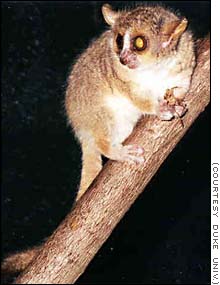According to scientists who studied the primate evolutionary tree, the current understanding of the evolutionary timetable needs to be revised

Avi Blizovsky
Gaps in the fossil record challenge the traditional view of the evolutionary tree. Now researchers say it is necessary to change the tree because the primates (the supreme creatures that include the apes, great apes and man) first appeared on earth 85 million years ago and not 65 million years as is commonly thought.
This change has ramifications throughout the primate evolutionary tree, including the timeline of human development. Important findings from the new interpretation of the archaeological findings include, among others:
* The primates existed while the dinosaurs ruled the earth. This challenges the accepted theory according to which the primates could not set foot until the end of the Cretaceous period (65 million years before our time, and also the end of the age of the dinosaurs) when a large asteroid hit the earth and destroyed the dinosaurs.
* The early origin of the primates spoils the hypothesis that changes in the structure of the continents caused a geographic subdivision of the primates.
* The new approach supports findings that were previously difficult to obtain from several evolutionary trees obtained by the method of genetic comparison between known parts of the mammalian tree. A comparison for example between mammal-like lizards, horses and marine mammals, where the fossil records are quite complete.
* Comparison with the fossil record of other mammals such as rats, is not reliable.
Current interpretations of primate and human evolution are wrong because paleontologists have relied too much on direct interpretations of the known fossil record." says Dr. Robert Martin, academic vice president at the Field Museum, and co-author of the article published in Nature on April 18, 2002. "Our calculations show that we have a fossil record of only five percent of all extinct primates. It's like trying to guess what a thousand-piece puzzle looks like when we only have 50 pieces."
The new statistical approach now fills in gaps in the fossil record. The earliest identified primate is 55 million years old. Most paleontologists believe that there were no primates 65 million years ago.
The current process of dating the origin of an entire group is to estimate the stratigraphic age of the existing fossils, then add a few million years." Dr. Martin explains. "This does not work well when talking about the primates because very few fossils have been found. Most fossils do include the structure of teeth and bones, and many of them are creatures known from only one fossil example.
The new statistical approach estimates the time period between the oldest fossil creature and the closest ancestor of a given group. The method also estimates the likely number of missing creatures in the group. The estimate is based on the fact that each species exists for an average of 2.5 million years. The necessary number of species along the way is called the stratigraphic interval, and the number of primate species living today (235) should be the minimum. The study authors conducted a re-examination of scientific papers describing 474 primate fossils. Fitting them to the new dating approach divided into stratigraphic intervals shows that there were between 8,000 and 9,000 extinct primate species still unknown to science. The conclusions can have many consequences in the fields of paleontology, anthropology, primatology and other fields. They require a reexamination of the story of primate evolution. For example, if primates originated 85 million years ago, then the splitting of the Gondana supercontinent during the Cretaceous might have caused a split and diversification among primates.
Also, the early date of the origin of the primates shows that they originated in the tropical and subtropical region, and from there they moved north, and not that they originated in the north as is commonly thought. According to the researchers, the reason no primate fossils were found in the south is that the weather near the equator in those days did not help the fossils to be preserved. The primordial primates were also relatively small, and this reduces their chances of predation and discovery.
New dates for the development trees
Many scientists use infrared dating of known fossils as an anchor for their work. In particular, molecular biologists rely on these derived dates in their attempts to construct a timeline for animal evolutionary trees. The molecular biologists estimate the length of time along the branches between known species by the changes in the DNA sequences. However, there is no way to derive a timetable from the molecular information alone.
To attach a timeline to a molecular tree, the practical way to do this is to rely on fossil dating. If the creature's age is excessively underestimated, the same happens to the other creatures in the chain. "We hope that our research will help to re-date the divergence between the species and not only among the primates" said Dr. Martin.
the ancestor of all primates
The primates that exist today are divided into six groups: lemurs, lorises, tricers, New World monkeys, Old World monkeys, great apes and humans. Their 85-million-year-old ancestor might have looked like a primitive, relatively small-brained version of the lemur. According to Dr. Martin, who has studied the trees of evolution from various aspects during the last 30 years.
This animal was tiny, lived on trees and weighed 200-400 grams, and had tiny hands and feet. The limbs were used by the babies to crawl on their mother's fur. They apparently had large front eyes, for spatial vision, as well as a short nose made possible by the reduction of teeth. He lived in the tropical or subtropical forests, ate mixed food - mainly insects and fruits. Like humans, his reproduction rate was relatively low, and was characterized by a relatively small number of offspring and investment in them.
In the photo: Lemur - the original primate was similar to him
https://www.hayadan.org.il/BuildaGate4/general2/data_card.php?Cat=~~~300495850~~~153&SiteName=hayadan
